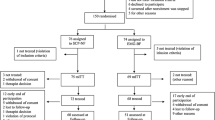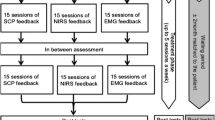Abstract
This study compared changes in quantitative EEG (QEEG) and CNV (contingent negative variation) of children suffering from ADHD treated by SCP (slow cortical potential) neurofeedback (NF) with the effects of group therapy (GT) to separate specific from non-specific neurophysiological effects of NF. Twenty-six children (age: 11.1 ± 1.15 years) diagnosed as having ADHD were assigned to NF (N = 14) or GT (N = 12) training groups. QEEG measures at rest, CNV and behavioral ratings were acquired before and after the trainings and statistically analyzed. For children with ADHD-combined type in the NF group, treatment effects indicated a tendency toward improvement of selected QEEG markers. We could not find the expected improvement of CNV, but CNV reduction was less pronounced in good NF performers. QEEG changes were associated with some behavioral scales. Analyses of subgroups suggested specific influences of SCP training on brain functions. To conclude, SCP neurofeedback improves only selected attentional brain functions as measurable with QEEG at rest or CNV mapping. Effects of neurofeedback including the advantage of NF over GT seem mediated by both specific and non-specific factors.



Similar content being viewed by others
References
Banaschewski T, Brandeis D, Heinrich H, Albrecht B, Brunner E, Rothenberger A (2003) Association of ADHD and conduct disorder-brain electrical evidence for the existence of a distinct subtype. J Child Psychol Psychiatry 44:356–376
Banaschewski T, Brandeis D, Heinrich H, Albrecht B, Brunner E, Rothenberger A (2004) Questioning inhibitory control as the specific deficit of ADHD-evidence from brain electrical activity. J Neural Transm 111:841–864
Barkley R (2006) Attention-deficit hyperactivity disorder. A handbook for diagnosis and treatment, 3rd edn. Gilford, New York
Barry RJ, Clarke AR, Johnstone SJ (2003a) A review of electrophysiology in attention-deficit/hyperactivity disorder: I. Qualitative and quantitative electroencephalography. Clin Neurophysiol 114:171–183
Barry RJ, Johnstone SJ, Clarke AR (2003b) A review of electrophysiology in attention-deficit/hyperactivity disorder: II. Event-related potentials. Clin Neurophysiol 114:184–198
Birbaumer N, Elbert T, Canavan AG, Rockstroh B (1990) Slow potentials of the cerebral cortex and behavior. Physiol Rev 70:1–41
Brandeis D, van Leeuwen TH, Rubia K, Vitacco D, Steger J, Pascual-Marqui RD, Steinhausen HC (1998) Neuroelectric mapping reveals precursor of stop failures in children with attention deficits. Behav Brain Res 94:111–125
Chabot RJ, di Michele F, Prichep L, John ER (2001) The clinical role of computerized EEG in the evaluation and treatment of learning and attention disorders in children and adolescents. J Neuropsychiatry Clin Neurosci 13:171–186
Clarke AR, Barry RJ, McCarthy R, Selikowitz M (2001) Age and sex effects in the EEG: differences in two subtypes of attention-deficit/hyperactivity disorder. Clin Neurophysiol 112:815–826
Conners CK, Sitarenios G, Parker JD, Epstein JN (1998a) The revised Conners’ Parent Rating Scale (CPRS-R): factor structure, reliability, and criterion validity. J Abnorm Child Psychol 26:257–268
Conners CK, Sitarenios G, Parker JD, Epstein JN (1998b) Revision and restandardization of the Conners Teacher Rating Scale (CTRS-R): factor structure, reliability, and criterion validity. J Abnorm Child Psychol 26:279–291
Curran S, Newman S, Taylor E, Asherson P (2000) Hypescheme: an operational criteria checklist and minimum data set for molecular genetic studies of attention deficit and hyperactivity disorders. Am J Med Genet 96:244–250
Doepfner M, Lehmkuhl G (2000) FBB-HKS [Rating-scale for hyperkinetic disorder from diagnostic system for mental disorders in childhood and adolescence according to ICD-10 and DSM-IV (DISYPS-KJ)], 2nd edn. Hogrefe, Göttingen
Drechsler R, Straub M, Doehnert M, Heinrich H, Steinhausen HC, Brandeis D (2007) Controlled evaluation of a neurofeedback training of slow cortical potentials in children with attention deficit/hyperactivity disorder (ADHD). Behav Brain Funct 3:35
Fuchs T, Birbaumer N, Lutzenberger W, Gruzelier JH, Kaiser J (2003) Neurofeedback treatment for attention-deficit/hyperactivity disorder in children: a comparison with methylphenidate. Appl Psychophysiol Biofeedback 28:1–12
Gioia GA, Isquith PK, Guy SC, Kenworthy L (2000) Behavior rating inventory of executive function. PAR, Odessa
Grawe K, Donati R, Bernauer F (2001) Psychotherapy in transition: from speculation to science, 5th edn. Hogrefe, Göttingen
Heinrich H, Gevensleben H, Freisleder FJ, Moll GH, Rothenberger A (2004) Training of slow cortical potentials in attention-deficit/hyperactivity disorder: evidence for positive behavioral and neurophysiological effects. Biol Psychiatry 55:772–775
Heinrich H, Gevensleben H, Strehl U (2007) Annotation: neurofeedback—train your brain to train behaviour. J Child Psychol Psychiatry 48:3–16
Hennighausen K, Schulte-Körne G, Warnke A, Remschmidt H (2000) Contingent negative variation (CNV) in children with hyperkinetic syndrome—an experimental study using the Continuous Performance Test (CPT). Z Kinder Jugendpsychiatr Psychother 28:239–246
Holtmann M, Stadler C (2006) Electroencephalographic biofeedback for the treatment of attention-deficit hyperactivity disorder in childhood and adolescence. Expert Rev Neurother 6:533–540
Holtmann M, Stadler C, Leins U, Strehl U, Birbaumer N, Poustka F (2004) Neurofeedback for the treatment of attention-deficit/hyperactivity disorder (ADHD) in childhood and adolescence. Z Kinder Jugendpsychiatr Psychother 32:187–200
Kropotov JD, Grin-Yatsenko VA, Ponomarev VA, Chutko LS, Yakovenko EA, Nikishena IS (2005) ERPs correlates of EEG relative beta training in ADHD children. Int J Psychophysiol 55:23–34
Leins U, Hinterberger T, Kaller S, Schober F, Weber C, Strehl U (2006) Neurofeedback for children with ADHD: a comparison of SCP and theta/beta-protocols. Prax Kinderpsychol Kinderpsychiatr 55:384–407
Loo SK, Barkley RA (2005) Clinical utility of EEG in attention deficit hyperactivity disorder. Appl Neuropsychol 12:64–76
Lubar JF, Swartwood MO, Swartwood JN, O’Donnell PH (1995) Evaluation of the effectiveness of EEG neurofeedback training for ADHD in a clinical setting as measured by changes in T.O.V.A. scores, behavioral ratings, and WISC-R performance. Biofeedback Self Regul 20:83–99
Magee CA, Clarke AR, Barry RJ, McCarthy R, Selikowitz M (2005) Examining the diagnostic utility of EEG power measures in children with attention deficit/hyperactivity disorder. Clin Neurophysiol 116:1033–1040
Monastra VJ, Lubar JF, Linden M, VanDeusen P, Green G, Wing W, Phillips A, Fenger TN (1999) Assessing attention deficit hyperactivity disorder via quantitative electroencephalography: an initial validation study. Neuropsychology 13:424–433
Monastra VJ, Monastra DM, George S (2002) The effects of stimulant therapy, EEG biofeedback, and parenting style on the primary symptoms of attention-deficit/hyperactivity disorder. Appl Psychophysiol Biofeedback 27:231–249
Monastra VJ, Lynn S, Linden M, Lubar JF, Gruzelier J, LaVaque TJ (2005) Electroencephalographic biofeedback in the treatment of attention-deficit/hyperactivity disorder. Appl Psychophysiol Biofeedback 30:95–114
Oosterlaan J, Sergeant JA (1998) Effects of reward and response cost on response inhibition in AD/HD, disruptive, anxious, and normal children. J Abnorm Child Psychol 26:161–174
Perchet C, Revol O, Fourneret P, Mauguiere F, Garcia-Larrea L (2001) Attention shifts and anticipatory mechanisms in hyperactive children: an ERP study using the Posner paradigm. Biol Psychiatry 50:44–57
Quintana H, Snyder SM, Purnell W, Aponte C, Sita J (2007) Comparison of a standard psychiatric evaluation to rating scales and EEG in the differential diagnosis of attention-deficit/hyperactivity disorder. Psychiatry Res 152:211–222
Rossiter T (2004) The effectiveness of neurofeedback and stimulant drugs in treating AD/HD: part II. Replication. Appl Psychophysiol Biofeedback 29:233–243
Rossiter TR, La Vaque TJ (1995) A comparison of EEG biofeedback and psychostimulants in treating attention deficit hyperactivity disorder. J Neurother 1:48–59
Sergeant J (2000) The cognitive-energetic model: an empirical approach to attention-deficit hyperactivity disorder. Neurosci Biobehav Rev 24:7–12
Sonuga-Barke EJ (2005) Causal models of attention-deficit/hyperactivity disorder: from common simple deficits to multiple developmental pathways. Biol Psychiatry 57:1231–1238
Strehl U, Leins U, Goth G, Klinger C, Hinterberger T, Birbaumer N (2006) Self-regulation of slow cortical potentials: a new treatment for children with attention-deficit/hyperactivity disorder. Pediatrics 118:e1530–e1540
Taylor E, Schachar R, Thorley G, Wieselberg M (1986) Conduct disorder and hyperactivity: I. Separation of hyperactivity and antisocial conduct in British child psychiatric patients. Br J Psychiatry 149:760–767
Thompson L, Thompson M (1998) Neurofeedback combined with training in metacognitive strategies: effectiveness in students with ADD. Appl Psychophysiol Biofeedback 23:243–263
van Leeuwen TH, Steinhausen HC, Overtoom CC, Pascual-Marqui RD, van’t Klooster B, Rothenberger A, Sergeant JA, Brandeis D (1998) The continuous performance test revisited with neuroelectric mapping: impaired orienting in children with attention deficits. Behav Brain Res 94:97–110
Acknowledgments
The authors thank Dr. H. Heinrich for providing the neurofeedback equipment and additional support as well as G. McLoughlin for her final reading of the manuscript.
Author information
Authors and Affiliations
Corresponding author
Additional information
M. Doehnert and D. Brandeis have contributed equally to this paper.
Rights and permissions
About this article
Cite this article
Doehnert, M., Brandeis, D., Straub, M. et al. Slow cortical potential neurofeedback in attention deficit hyperactivity disorder: is there neurophysiological evidence for specific effects?. J Neural Transm 115, 1445–1456 (2008). https://doi.org/10.1007/s00702-008-0104-x
Received:
Accepted:
Published:
Issue Date:
DOI: https://doi.org/10.1007/s00702-008-0104-x




